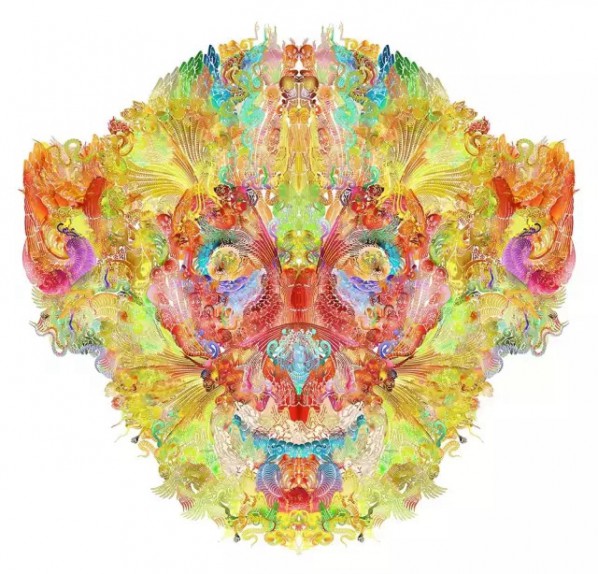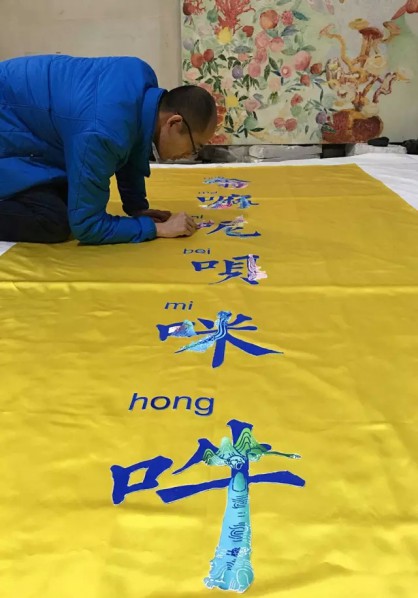
Wu Jian'an's work the Monkey King Fears Nothing
To celebrate the 100th anniversary of the Met's Department of Asian Art, Met museum held a grand festival, Lunar New Year Festival: Year of the Monkey on February 6, 2016, inviting standout performance artists, visual artists and cultural institutes to produce artist-led interactive gallery activities and special exhibitions for visitors of all states and ages.
As a preeminent artist with remarkble creativity and rich in thoughts, Wu Jian'an, from Beijing, took 6 hours in Gallery 208, one presented Met's most important Asian art collections, to produce an anticipated art creatation of installation activity: "Release the Buddhist mantra and free the Monkey King" on the event day.
By unremittingly thinking and exploring new manner, Wu Jian'an utilizes multiple media and complex methods to combine contemporary radical aesthetics and cultural attitude with the local tradition of Chinese art, creates multilayered compositions and large-scale installation art with thousands of components. By means of unique art style and affluent enlightenment, his works make him contribute to the development of Chinese ancient tradition, and promote the current cultural exchange between East and West.
This time, the activity he specially and exclusively prepared for Met Lunar New Year Celebrates was related to the famouse Chinese classic Journey to the West.

Wu Jian'an works on the mantra in his Beijing studio, 2016
“As we know, in the story of Chinese classical novel Journey to the West, the Monkey King Sun Wukong was imprisoned in a mountain (also known as the five pillar mountain) for 500 years. Due to the paper talisman written the mantra “Ong Ma Ni Bei Mi Hong”, Wukong could never escape, until Xuan Zang, a monk of the Tang Dynasty, released the talisman under the guidance of Avalokitesvara (guanyin), the Monkey King was finally free.
The five pillar mountain was a transformation of Buddha's own hand, and many ancient Buddism Sculpture in Met museum are armless. Apart from the realistic reasons, are there any fantastic or implied relations in regard to this situation? So, I wish to invite as much audiences as I can on the event day to imagine and draw what the lost arms of ancient Buddhist sculptures would like. I will cut the arms of their drawings out, and reassemble them to the prepared mantra to form a new image on the spot. Whoever started the trouble should end it. With the help of the 'Buddha's arms', the audience and I will make an artistic action of releasing the Buddhist mantra, and this willl be an intrsting way, in this special time and space, to interpreting and experience Chinese cultural classic, and welcome the Lunar New Year together.”
–Wu Jian’an
-Hollowdry-lacquer-with-traces-of-gilt-and-polychrome-pigment-and-gilding-Buddha-Amitabha-449x598.jpg)
Tang dynasty (618–907, early 7th century) Hollowdry lacquer with traces of gilt and polychrome pigment and gilding Buddha Amitabha (Picture Source: the Metropolitan Museum of Art)
There are many Buddha statues throughout neighboring galleries (207, 211, 223, 224, 236, 237, 238, 247, 250) that have lost hands and arms due to time and travel. Find one, and imagine what the missing limb might have looked like, what gesture might he be making, how might the fabric have draped? Draw this arm on our provided papers and bring your drawing into a basket in the doorway of gallery 208, the artist working there will reassemble them to form a new image.
The moment you finish your drawing, your own imagination will make a cross-time-and-space combination with stunning art works from long ago. Then they will become an essential part of the charming, growing contemporary art, under the gaze from these precious cultural heritage and audience, on account of the creation of the standout artist. Once 1000 arms are collected and added, the mantra was revealed!
About the artist
Wu Jian'an, 1980 Born in Beijing, China.
Currently lives and works in Beijing. Associate Professor and Master Tutor at China Central Academy of Fine Art, member of China Artists Association, researcher of China Traditional Skill Research and Preservation Center of Prince Gung's Palace Musuem.
In recent years, his works have been successively exhibited in Live and Let Live: Creators of Tomorrow—the 4th Fukuoka Asian Art Triennale (Fukuoka Asian Art Museum, Fukuoka, Japan, 2009), ALLES UNTER DEM HIMMEL GEHORT ALLEN Chinese Public Art in Kassel (Kassel, Germany, 2012), Cosmos: the Openning exhibition (Shanghai 21st Century Minsheng Art Museum, Shanghai, China, 2014), the Carolyn Hsu and René Balcer Collection: Exploring Three Decades of Contemporary Chinese Art (Museum of Fine Arts, Boston, USA, 2015), Echo of Civilization: Crossing Dunhuang (Imperial Ancestral Temple Art Museum of China, Beijing, China, 2016), and he have held solo exhibitions in Beijing, Shanghai, New York and Singapore. His works have become collections of many museums, foundations and collectors.
About the event
Collaborative Installation Art with Wu Jian'an: Release the Buddhist mantra”Date: February 6th, 2016 Saturday
Time: 11:30 a.m.—5:30 p.m.
Location: Gallery 208, First floor
Courtesy of the artist and Met, for further information please visit http://www.metmuseum.org/events/programs/met-celebrates/festivals-and-special-programs/lunar-new-year-2016.




























